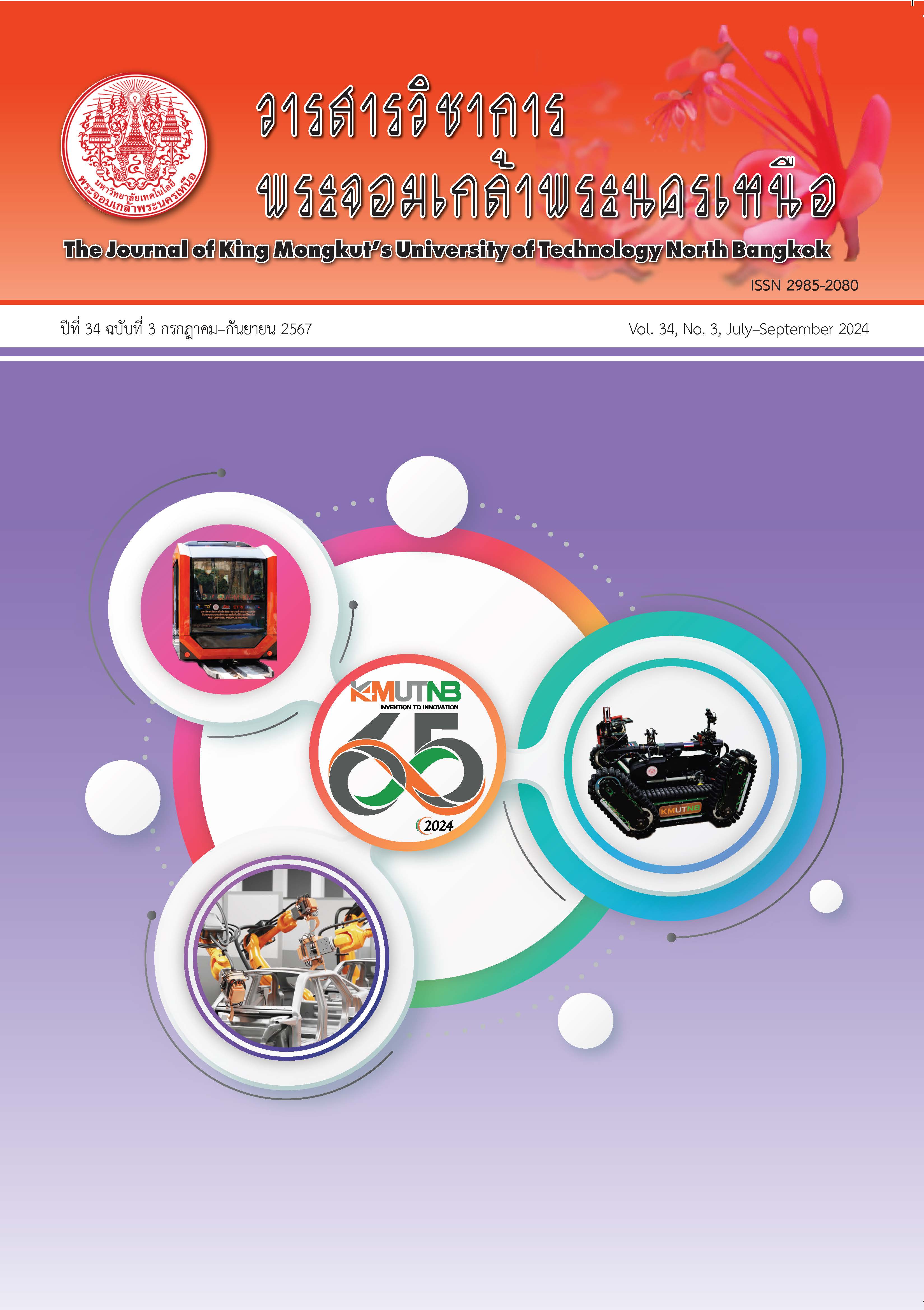การประยุกต์ใช้ระบบเครือข่าย LoRaWAN สำหรับการตรวจสอบพลังงานไฟฟ้าและการจัดเก็บข้อมูลในอาคารอัจฉริยะ
Main Article Content
บทคัดย่อ
เทคโนโลยีอินเทอร์เน็ตทุกสรรพสิ่งบนพื้นฐานเครือข่ายบริเวณกว้าง LPWAN (Low-Power Wide-Area Network) ที่ใช้พลังงานต่ำเหมาะกับการใช้งานสำหรับเครื่องมือวัดและระบบการตรวจวัดพลังงานไฟฟ้าจากมาตรวัดแบบดั้งเดิมพัฒนาไปเป็นมาตรวัดแบบอัจฉริยะสำหรับระบบการตรวจวัดพลังงานของหม้อแปลงไฟฟ้าในระบบจำหน่าย โรงงานและอาคารอัจฉริยะ โดยเครือข่าย LoRaWAN (Long Range Wide Area Network) เป็นหนึ่งในเทคโนโลยี LPWAN ที่มีบทบาทสำคัญและเหมาะสำหรับใช้ในการเชื่อมต่อเครือข่าย IoT ในการตรวจวัดพลังงานไฟฟ้าอัจฉริยะเพราะสามารถสื่อสารได้ในระยะทางไกล ใช้ความถี่ที่ไม่มีใบอนุญาต และราคาต้นทุนต่ำ ดังนั้นงานวิจัยนี้จึงนำเสนอการประยุกต์ใช้ระบบเครือข่าย LoRaWAN สำหรับการตรวจสอบพลังงานไฟฟ้าและการจัดเก็บข้อมูลในอาคารอัจฉริยะ เพื่อตรวจสอบและจัดการการใช้พลังงานในอาคารอัจฉริยะ โดยใช้โนดเซ็นเซอร์ (มาตรไฟฟ้าแบบดิจิตอลรวมกับโมดูลสื่อสาร LoRa) วางไว้ในแต่ละชั้นของอาคารและใช้เกตเวย์ LoRaWAN แบบหลายช่องสัญญาณ โดยในการประเมินประสิทธิภาพของระบบที่นำเสนอได้ทำการวัดและคำนวณตัวบ่งชี้ 3 ตัวคือ ความแรงของสัญญาณที่ได้รับ (RSSI) อัตราส่วนสัญญาณต่อสัญญาณรบกวน (SNR) และอัตราการส่งข้อมูลสำเร็จ (PDR) โดยผลการวัดทดสอบพบว่าค่า RSSI ในแต่ละชั้นจากชั้นที่ไกลที่สุดจนถึงชั้นเดียวกับเกตเวย์มีค่าเฉลี่ย -110 ถึง -33 เดซิเบลมิลลิวัตต์ ขณะที่ SNR สูงสุดคือ 12.08 เดซิเบล และ SNR ต่ำสุดคือ -5.28 เดซิเบล ซึ่งผลการทดสอบแสดงให้เห็นว่าเกตเวย์ 8 ช่องสัญญาณเพียงตัวเดียวสามารถครอบคลุมอาคาร 8 ชั้น โดยที่มีอัตราการส่งข้อมูลสำเร็จมีค่ามากกว่า 80% ประสิทธิภาพและสามารถครอบคลุมของสถานที่ทดสอบทั้งหมด จากการวิเคราะห์ผลผ่านพารามิเตอร์ RSSI SNR และ PDR ที่เป็นตัวชี้วัดประสิทธิภาพเครือข่าย LoRaWAN พบว่าการประยุกต์ใช้เครือข่าย LoRaWAN สำหรับการตรวจสอบพลังงานไฟฟ้าและการจัดเก็บข้อมูลในอาคารอัจฉริยะสามารถเพิ่มความเชื่อมั่นและความน่าเชื่อถือของระบบการตรวจสอบพลังงานไฟฟ้าอัจฉริยะ
Article Details

อนุญาตภายใต้เงื่อนไข Creative Commons Attribution-NonCommercial-NoDerivatives 4.0 International License.
บทความที่ลงตีพิมพ์เป็นข้อคิดเห็นของผู้เขียนเท่านั้น
ผู้เขียนจะต้องเป็นผู้รับผิดชอบต่อผลทางกฎหมายใดๆ ที่อาจเกิดขึ้นจากบทความนั้น
เอกสารอ้างอิง
Y. Xu and A. Helal, “Scalable cloud–sensor architecture for the Internet of Things,” IEEE Internet of Things Journal, vol. 3, no. 3, pp. 285–298, 2016.
K. Mekki, E. Bajic, F. Chaxel, and F. Meyer, “Overview of cellular LPWAN technologies for IoT deployment: Sigfox, LoRaWAN, and NB-IoT,” in Proceedings IEEE International Conference on Pervasive Computing and Communications Workshops (PerCom Workshops), 2018, pp. 197–202.
R. Sinha, Y. Wei, and S. Hwang, “A survey on LPWA technology: LoRa and NB-IoT,” ICT Express, vol. 3, no. 1, pp. 14–21, 2017.
P. Masek, M. Stusek, K. Zeman, R. Drapela, A. Ometov, and J. Hosek, “Implementation of 3GPP LTE Cat-M1 technology in NS-3: System simulation and performance,” in Proceedings 11th International Congress on Ultra Modern Telecommunications and Control Systems and Workshops (ICUMT), Dublin, Ireland, 2019, pp. 1–7.
NBTC. (2017, November). Technical standards of telecommunication equipment and for radiocommunication equipment Non-RFID, which uses the frequency band 920-925 MHz NBTC TS 1033-2560. [Online]. Available: http://www.ratchakitcha.soc.go.th/DATA/ PDF/2560/E/289/51.PDF
CAT Telecom PCL. (2019, May). Internet of things long range IoT. [Online]. Available: https://loraiot.cattelecom.com/site/home
S. Sadowski and P. Spachos, “RSSI-based indoor localization with the internet of things,” IEEE Access, vol. 6, pp. 30149–30161, 2018.
S. Chaimool and K. Boonlom, “Evaluation of IoT LoRaWAN for smart cities: Environment monitoring use-case,” in Proceedings 41th Electrical Engineering Conference, 2018 (in Thai).
U. Raza, P. Kulkarni, and M. Sooriyabandara, “Low power wide area networks: An overview,” IEEE Communications Surveys & Tutorials, vol. 19, no. 2, pp. 855–873, 2017.
F. Adelantado, X. Vilajosana, P.T. Peiro, B. Martinez, J.M. Segui, and T. Watteyne, “Understanding the limits of LoRaWAN,” IEEE Communications Magazine, vol. 55, no. 9, pp. 34–40, 2017.
P. Boonyopakom and T. Thongna, “Environment monitoring system through LoRaWAN for smart agriculture,” in Proceedings 5th International Conference on Information Technology (InCIT), Chon Buri, Thailand, 2020, pp. 12–16 (in Thai).
M. M. Erbati, G. Schiele, and G. Batke, “Analysis of LoRaWAN technology in an outdoor and an indoor scenario in Duisburg-Germany,” in Proceedings 3rd International Conference on Computer and Communication Systems (ICCCS), Nagoya, Japan, 2018, pp. 273–277.
L. Maziero, T.B. Marchesan, C.H. Barriquello, D.P. Bernardon, F. G. Carloto, F. G. Reck, W. D. Vizzotto, and F. V. Garcia, “Monitoring of electric parameters in the federal university of Santa Maria using LoRaWAN technology,” in Proceedings IEEE PES Innovative Smart Grid Technologies Conference - Latin America (ISGT Latin America), Gramado, Brazil, 2019, pp. 1–6.
M. A. Ertürk, M. A. Aydın, M. T. Büyükakkaşlar, and H. A. Evirgen, “Survey on LoRaWAN architecture, protocol and technologies,” Future Internet, vol. 11, no. 10, 2019.
P. Gotthard and T. Jankech, “Low-cost car park localization using RSSI in supervised lora mesh networks,” in Proceedings 15th Workshop on Positioning, Navigation and Communications (WPNC), Bremen, Germany, 2018, pp. 1–6.
S. Hosseinzadeh, H. Larijani, K. Curtis, A. Wixted, and A. Amini, “Empirical propagation performance evaluation of LoRa for indoor environment,” in Proceedings IEEE 15th International Conference on Industrial Informatics (INDIN), Emden, Germany, 2017, pp. 26–31.
B. Islam, M. T. Islam, J. Kaur, and S. Nirjon, “LoRaIn: Making a case for LoRa in indoor localization,” in Proceedings IEEE International Conference on Pervasive Computing and Communications Workshops (PerCom Workshops), Kyoto, Japan, 2019, pp. 423–426.
M. J. Faber, K. M. van der Zwaag, W. G. V. dos Santos, H. R. d. O. Rocha, M. E. V. Segatto, and J. A. L. Silva, “A theoretical and experimental evaluation on the performance of LoRa technology,” IEEE Sensors Journal, vol. 20, no. 16, pp. 9480–9489, 2020.
H. Mroue, A. Nasser, B. Parrein, S. Hamrioui, E. Mona-Cruz, and G. Rouyer, “Analytical and simulation study for LoRa modulation,” in Proceedings 25th International Conference on Telecommunications (ICT), Saint Malo, France, 2018, pp. 655–659.
Nectec. (2020, May). Industrial communication with modbus protocol. [Online]. Available: https://www.nectec.or.th/news/news-publicdocument/ modbus-protocol.html
Semtech. (2017, December). Semtech SX1276 LoRa core. [Online]. Available: https://www. semtech.com/products/wireless-rf/lora-core/ sx1276
Semtech. (2019, January). Semtech SX1301 LoRa core. [Online]. Available: https://www. semtech.com/products/wireless-rf/lora-core/ sx1301
O. Brocaar. (2015, January). The chirpStack open-source LoRaWAN network server. [Online]. Available: https://www.chirpstack.io
B. Mishra and A. Kertesz, “The use of MQTT in M2M and IoT systems: A survey,” IEEE Access, vol. 8, pp. 201071–201086, 2020.
Grafana Labs. (2014, August). Grafana the open observability platform. [Online]. Available: https://grafana.com/oss/grafana
Influxdata. (2015, February). Build on influxDB. [Online]. Available: https://www.influxdata. com/products/influxdb
M. Skooijman. (2016, February). Arduino LMIC library LoRaWAN. [Online]. Available: https:// github.com/matthijskooijman/lmic
O. Brocaar. (2020, July). ChirpStack network server. [Online]. Available: https://github.com/ brocaar/chirpstack-network-server
Cayenne Docs. (2016, February). Cayenne low power payload. [Online]. Available: https:// mydevices.com/cayenne/docs/lora
M. Bor and U. Roedig, “LoRa transmission parameter selection,” in Proceedings 13th International Conference on Distributed Computing in Sensor Systems (DCOSS), Ottawa, Canada, 2017, pp. 27–34.
K. Lin and T. Hao, “Experimental link quality analysis for LoRa-based wireless underground sensor networks,” IEEE Internet of Things Journal, vol. 8, no. 8, pp. 6565–6577, 2021.
N. Jovalekic, V. Drndarevic, I. Darby, M. Zennaro, E. Pietrosemoli, and F. Ricciato, “LoRa transceiver with improved characteristics,” IEEE Wireless Communications Letters, vol. 7, no. 6, pp. 1058– 1061, 2018.
W. Xu, J. Y. Kim, W. Huang, S. S. Kanhere, S. K. Jha, and W. Hu, “Measurement, characterization, and modeling of LoRa technology in multifloor buildings,” IEEE Internet of Things Journal, vol. 7, no. 1, pp. 298–310, 2020.
I. Bobkov, A. Rolich, M. Denisova, and L. Voskov, “Study of LoRa performance at 433 MHz and 868 MHz bands inside a multistory building,” in Proceedings Moscow Workshop on Electronic and Networking Technologies (MWENT), Moscow, Russia, 2020, pp. 1–6.

